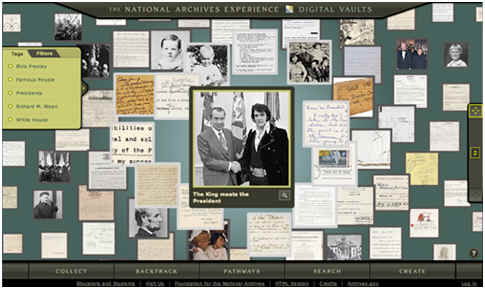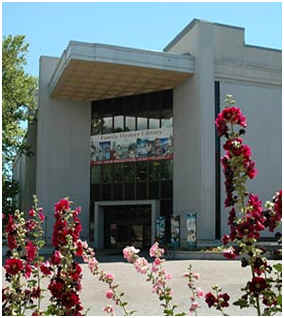|
Son las 5 de la
mañana del dia 30 de abril de 2008 en ciudad Victoria, Tamaulipas;
suena la alarma del despertador y es la hora para levantarme,
ducharme, y emprender el viaje que me ha de llevar al pueblo donde
nacieron los padres de mi mamá y bastante de la parentela
anterior a ellos.
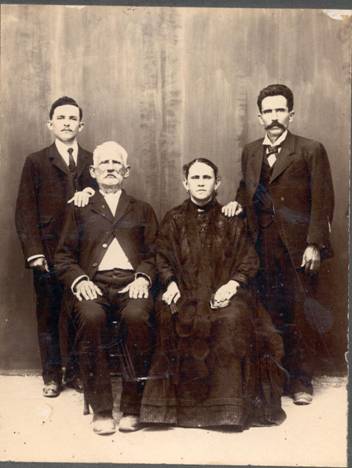 Desde
la semana anterior, emocionado como niño, he procurado los
preparativos para esta aventura genealógica y no he querido que
se olvide ni el mas mínimo detalle: llamadas telefónicas a la
presidencia municipal para concertar una audiencia con el alcalde;
un mapa del municipio y otro del pueblo; información
geográfica y estadísticas de población; los documentos que he
trabajado como árboles genealógicos sobre apellidos del pueblo:
los de la Garza (algunas 5 ó 6 ramas diferentes), Cano (tal vez 3
ramas), Leal y León (labor incompleta hasta los hijos del
capitán Antonio Leal de León), Ballí (el apellido que se fue a
otro pueblo); mis cuadernos de transcripción de los registros
parroquiales y civiles; la trasijada cámara fotográfica;
grabadora de bolsillo; guitarra y harmónica, a sleeping bag,
sábana, cobija cobertor y almohada; otros apuntes sobre apellidos
también comunes de Burgos tales como los Flores, Treviño,
González, Zúñiga, Polanco, Palacios, Camarillo, Rivera, Adame;
etcétera y mas etcétera. Desde
la semana anterior, emocionado como niño, he procurado los
preparativos para esta aventura genealógica y no he querido que
se olvide ni el mas mínimo detalle: llamadas telefónicas a la
presidencia municipal para concertar una audiencia con el alcalde;
un mapa del municipio y otro del pueblo; información
geográfica y estadísticas de población; los documentos que he
trabajado como árboles genealógicos sobre apellidos del pueblo:
los de la Garza (algunas 5 ó 6 ramas diferentes), Cano (tal vez 3
ramas), Leal y León (labor incompleta hasta los hijos del
capitán Antonio Leal de León), Ballí (el apellido que se fue a
otro pueblo); mis cuadernos de transcripción de los registros
parroquiales y civiles; la trasijada cámara fotográfica;
grabadora de bolsillo; guitarra y harmónica, a sleeping bag,
sábana, cobija cobertor y almohada; otros apuntes sobre apellidos
también comunes de Burgos tales como los Flores, Treviño,
González, Zúñiga, Polanco, Palacios, Camarillo, Rivera, Adame;
etcétera y mas etcétera.
Voy por la
carretera rumbo a Matamoros, Tamaulipas y en la soledad que ofrece
durante dos horas y media el interior de un carro en movimiento a
una velocidad de entre 80 y 100 kilómetros, por mi mente da
vueltas toda la información que desde hace diez años ha llegado
desde que inicié esta particular adicción por la genealogía.
En todos los
pueblos que voy pasando: Güemez, Padilla, Jiménez, Cruillas; y
los de los alrededores: Santa Engracia, Barretal, Hidalgo, San
Nicolás, San Carlos, Méndez, Villagrán, San Fernando, Soto la
Marina, Linares, Montemorelos, Cadereyta, Santiago Guaxuco,
Cerralvo, las Ciénegas, Saltillo y Monterrey; desde el inicio del
tiempo de su colonización años 1600-1750, ha existido el
apellido “de la Garza”, hoy en muchos casos simplificado a “Garza”
tal vez por decisión familiar o por omisión de los oficiales del
registro civil.
Las personas con
apellido “de la Garza” que a la fecha viven y han vivido en el
noreste de México y en el sur de Texas, y también los que eran
de ahí pero se fueron a vivir para otras partes, tenemos una
raíz común que proviene de Marcos Alonso de la Garza Falcón,
quien fincó residencia por 1580 en Mapimí, Durango, un Real
minero vecino del Estado de Coahuila.
Se dice que éste
Marcos Alonso de la Garza Falcón, alguna bibliografía
distingue este apelativo como “de la Garza y Arcón”,
nació por el año de 1561 en Lepe, Huelva, Castilla, España,
y que sus padres fueron Marcos Alonso y Constanza de la
Garza. Constanza
de la Garza nació por 1529 en Lepe, Huelva, y se casó por 1550
con Marcos Alonso que nació por 1525 también en Lepe.
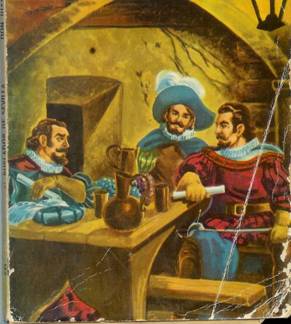 Mi
búsqueda sobre los orígenes del apellido de la Garza, me ha
llevado a encontrar a una Constanza de
la Garza y a su hermano Alonso de la Garza quienes el 24
de febrero de 1528 en la ciudad de La Palma de las Islas Canarias,
España, fueron condenados por el
Santo Oficio de la Inquisición en Sevilla a su ejecución
a muerte quemados en la hoguera, porque desde que vivían en Lepe
se les había advertido la inconveniencia de sus creencias, por lo
que decidieron irse a vivir a las Islas Canarias donde
supuestamente la Inquisición era mas benévola, pero igual ahí
siguieron profesando su religión; el cargo con el que se les
condenó fue por fistol
infidente y relapso, por sus adoratorios al Torah y por
hablar el idioma hebreo.
Esta Constanza y su hermano Alonso de la Garza eran
hijos de Herman Garza de la Garza quien
se casó en Sevilla con Beatriz Núñez; y al parecer esta familia
fue a vivir a Lepe, Huelva, donde nacieron sus hijos. Mi
búsqueda sobre los orígenes del apellido de la Garza, me ha
llevado a encontrar a una Constanza de
la Garza y a su hermano Alonso de la Garza quienes el 24
de febrero de 1528 en la ciudad de La Palma de las Islas Canarias,
España, fueron condenados por el
Santo Oficio de la Inquisición en Sevilla a su ejecución
a muerte quemados en la hoguera, porque desde que vivían en Lepe
se les había advertido la inconveniencia de sus creencias, por lo
que decidieron irse a vivir a las Islas Canarias donde
supuestamente la Inquisición era mas benévola, pero igual ahí
siguieron profesando su religión; el cargo con el que se les
condenó fue por fistol
infidente y relapso, por sus adoratorios al Torah y por
hablar el idioma hebreo.
Esta Constanza y su hermano Alonso de la Garza eran
hijos de Herman Garza de la Garza quien
se casó en Sevilla con Beatriz Núñez; y al parecer esta familia
fue a vivir a Lepe, Huelva, donde nacieron sus hijos.
También
por ahí encontré una historia de un tal Juan de la Garza, que
por allá de 1535 había protagonizado una pelea con heridas de
navaja cuando era parte de la tripulación en un galeón español
que atracó en un puerto de América del Sur; este Juan de la
Garza era un gaditano, que es el gentilicio para las personas
oriundas del Puerto de Cádiz, España, y que ha de haber andado
por lo menos en los 18 años de edad; o sea que nació en Cádiz
por el año de 1517.
Otro
dato interesante es el que me dio mi amigo español de la ciudad
de Huelva, España, el señor Ángel Custodio Rebollo Barroso,
cuyo correo electrónico dice: “hace
unos días, estudiando un tema del Archivo General de Simancas, me
encontré con el Capitán Agustín de la Garza, quien pertenecía
a la milicia de Buenos Aires en Argentina y el expediente
comprende desde 1791 hasta 1798.
He conseguido leer completo el legajo que forma este expediente de
79 paginas y encuentro a un hombre obsesionado con enviar
instancias al rey ofreciéndole un plan secreto para conseguir que
Inglaterra devuelva Gibraltar. Siempre dice que es un plan muy
secreto y que hay que efectuarlo con el máximo sigilo para que ni
siquiera sospeche el enemigo. Casi todas las instancias están
informadas al margen por lo militares, catalogando las ideas de
Agustín de la Garza, como propias de una persona que no esta en
su sano juicio”.
También
platica mi amigo Ángel Custodio que su esposa
nació en Burgos, Santander, España, y que es nieta de José
Aguirre Sainz de la Garza, un veterinario que vivió en un pueblo
a unos 20 kilómetros de Santander.
Hay otro personaje “de la Garza” ubicado
allá por los 1600 en Compostela, Nueva España, lo que ahora es
el Estado de Nayarit o el de Colima, pero no he tenido la
oportunidad de transcribir los documentos que tratan sobre una
probanza de sangre como requisito para pertenecer al Santo Oficio
de la Inquisición.
Hubo un tiempo en que encontré por internet
domicilios de personas con apellido de la Garza que viven en
España; redacté una carta y la envié por correo postal; algo
así como 30 domicilios y de ello me contestaron por internet 2
señores.
Uno de ellos es el señor abogado Joaquín Homs Sánz de la Garza, de la ciudad de Barcelona, quien me
platica que la señora Eloisa de la Garza, su bisabuela materna,
ostentó un Ducado
que hace tiempo se
había perdido por desuso pero que actualmente ya está
rehabilitado.
El otro señor que respondió mi correo fue
el señor Manuel
Espinosa de la Garza, hijo
de Josefina
Plácida de la Garza y López Seoane, nieto de Don
César
de la Garza y Tapia, y bisnieto de don Jerónimo
de la Garza, nacido por 1757 en un pueblo del
norte de la provincia de Burgos, tal vez Balmaceda; y
tataranieto de un gran metalurgista español don Francisco
de la Garza, quien después de remitirme al tomo G,
página 917 de la enciclopedia Espasa,
me dice que según recuerda por las platicas que alguna vez
su madre decía que estos “de la Garza” habían venido de
Méjico hacía varias generaciones.
En
la enciclopedia Espasa tomo
G, página 917
dice: “garza {francisco de la), Biog. Metalurgista español, nació en Valdenoceda en 1757 y
murió en Madrid en 1832.
Estudió matemáticas en la corte y luego continuó sus estudios
en la Escuela Especial de Almadén, creada
por el alemán Enrique Astorr, siendo el primero
que salió con titulo de aquel centro; En 1788 sucedió á
Hoppensak en la dirección de las minas de Almadén y de
Ahnadenejos, desempeñando al mismo tiempo importantes comisiones.
En 1796 pasó á Alemania y
Austria para ampliar sus conocimientos, que, á su regreso á
España, aplicó con gran ventaja á nuestras
minas. En 1801 fue de nuevo nombrado director de las
minas de Almadén y luego teniente de superintendente subdelegado del gobernador, destinos que desempeñó
por espacio de catorce años, en los que introdujo
notables mejoramientos en el aprovechamiento de minerales, Al
ser organizado en 1825 el Cuerpo de ingenieros de minas, garza fue nombrado inspector general segundo del mismo. Se le
debe: Observaciones y
experimentos sobre el beneficio de las minas
de plata por la amalgamación, publicadas
en el tomo III de los Anales de Ciencias Naturales;
Mi teoría sobre las
utilidades y ventajas que puede producir
el carbón de piedra descubierto en Espiel Bébncz y Vtílarroya,
acompañada de un
plano del valle de Espíel;
Informe dado en el año de 1756... sobre e! estado y
mejoras de que es susceptible la mina de Almadén; Traducción
de; lecciones de Geometría subterránea publicadas
por el profesor M&eling en nSZ¡ y
Traducción
de la obra de Juan Federico Eiler “
también
Espasa
incluye:
garza y bañuei.os (ciríaco
de la), Biog. Pintor
español, nació en Juvilla del
Agua (Burgos), Fue discípulo de la Escuela Especial de
Pintura y de Marcelino Santamaría,
Obras principales: La primera hazaña del
Cid (1897); Dragon
y 1-lares (1899); Madre y maestra (1301);
Una Pastoral verde, y Toma sepilas (1904).
Ya por esta parte del camino tengo el sol
de la mañana enfrente y se dificulta ver la carretera; estoy
a las orillas de Santander Jiménez, Tamaulipas y decido
hacer un alto de trayecto para respirar aire fresco, escuchar el
canto de los pájaros y ver algunas mariposas volar.
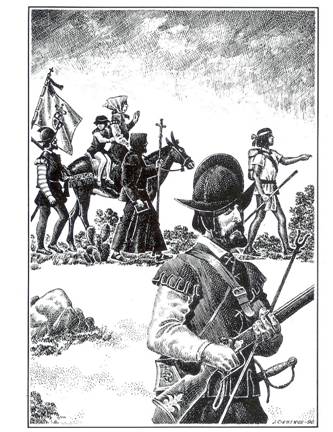 Aquí
en Jiménez, Don José de Escandón y Helguera, fincó residencia
familiar después de haber fundado las villas del Nuevo Santander;
hoy los niños de los ejidos caminan con los libros bajo el brazo
por la vereda a su escuela; los señores a lomo de burro van a la
labor, y los techos de las chozas soplan humo de leña de mezquite
con aroma a café hervido y frijoles de olla, cuando
no muy lejos se escuchan los aplausos de las señoras que
echan con las manos las tortillas del nixtamal de maíz.
Alguien dijo que las señoras le aplauden a Dios por haber
inventado el maíz; milagrosa
fuente de alimento natural. Aquí
en Jiménez, Don José de Escandón y Helguera, fincó residencia
familiar después de haber fundado las villas del Nuevo Santander;
hoy los niños de los ejidos caminan con los libros bajo el brazo
por la vereda a su escuela; los señores a lomo de burro van a la
labor, y los techos de las chozas soplan humo de leña de mezquite
con aroma a café hervido y frijoles de olla, cuando
no muy lejos se escuchan los aplausos de las señoras que
echan con las manos las tortillas del nixtamal de maíz.
Alguien dijo que las señoras le aplauden a Dios por haber
inventado el maíz; milagrosa
fuente de alimento natural.
Ya son las 8 de la mañana, apenas voy a
cruzar el punto de revisión militar de Las Norias y un anuncio
dice que a la izquierda a 75 kilómetros está Burgos.
Los señores del ejército muy amables me preguntan que de
donde vengo y a donde voy;
geográficamente les respondo pero después de reanudar el
camino me quedo pensando que, viéndolo bien esa respuesta
ni yo mismo la sé.
Poco mas adelante por la carretera está la
intersección a mi destino; hago otra parada para tomar una
fotografía velada a la señora que vende camarón fresco de la
Laguna Madre, sutil sabor a salado refugio de mar, con jugo de
limón y salsa picante, a quien no se le ha de antojar.
Apenas a unos metros de iniciar este tramo
final de mi ida, un señor me pide “raid” él se llama Rosendo
González Padilla y va para Cruillas a renovar su credencial de
elector para votar, y porque le van a dar una ayuda del gobierno
por ser adulto de la tercera edad; su motivo de estar parado a la
orilla de la carretera es para esperar que pase alguien que
lo lleve y porque solo hay dos autobuses de transporte
público, uno que viene de San Fernando y pasa por ahí como a las
once de la mañana, mismo que se regresa en seguida ese mismo día,
y que éste sí se detiene a levantar pasaje de la gente que le
hace la parada por el camino; y el otro que vine de Reynosa, llega
por la tarde y se regresa al día siguiente por la mañana;
pero es vía directa y no levanta pasaje ni siquiera en San
Fernando. Me platicó
este señor, que su papá había tenido tierras en un ejido de por
aquí, pero que ya luego cuando heredaron, sus hermanos las
vendieron para irse a vivir a la ciudad; que él solo conservó un
rancho donde tiene algunas chivas y que ya no siembra maíz porque
le sale mas caro, y ahora prefiere comprar lo que necesita para el
uso diario; también me platicó que tres de sus ocho hijos se
fueron de mojados para trabajar al otro lado, del Río Bravo, Rio
Grande.
Ya estoy llegando a Burgos y el anuncio de
bienvenida dice que tiene una población de 975 habitantes;
después en pláticas con algunos señores del pueblo alguien me
dijo que esa cifra ya no es real, que hoy son mas.
¿cuántos mas podrán ser? ¿ tal vez algunos 1500?
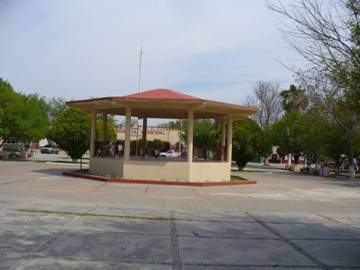 Lo
primero que hice al entrar al pueblo fue ir directamente donde la
plaza central; en el ambiente se siente el afable ánimo de la
gente porque hoy 30 de abril se festeja el dia del niño; y Lo
primero que hice al entrar al pueblo fue ir directamente donde la
plaza central; en el ambiente se siente el afable ánimo de la
gente porque hoy 30 de abril se festeja el dia del niño; y
por lo pronto se trata de antes almorzar
para empezar a trabajar; ahí está el restaurante “3 hermanos
Cano” y sirven un exquisito machacado con huevo, de
rechupetearse los dedos; el machacado es carne de res seca
machacada, o sea fregada con un martillo de madera, y deshebrada.
Después
de rentar una habitación en el hotel del señor Arnulfo Salinas
Guillén regreso a la plaza central donde está la presidencia
municipal y la Iglesia de Nuestra Señora de Loreto fundada en
1749 por Fray Simón del Hierro; su templo parroquial fue
construido en 1792 y las vigas de madera en su cielo fueron
traídas de Europa.
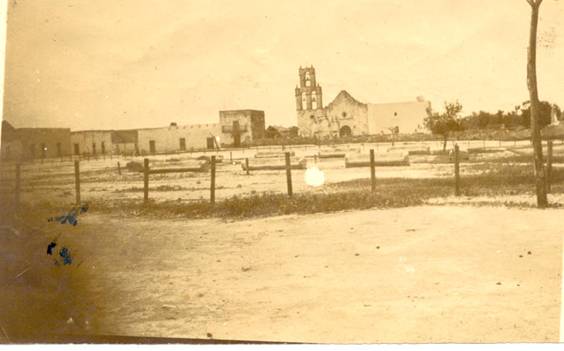
Plaza
de Burgos, Tamaulipas
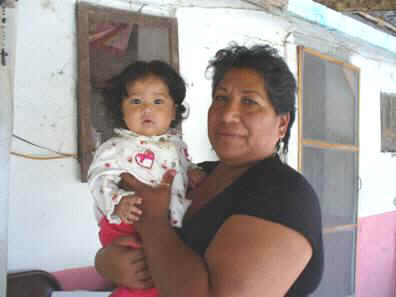 Caminando
por ahí en sus calles la gente me dice que en Burgos ya no hay
personas con apellido “de la Garza”; solamente una familia que
hoy vive por la Calle Juárez, la que en 1900 se llamaba Calle del
Comercio; ésta
familia es la de don Caminando
por ahí en sus calles la gente me dice que en Burgos ya no hay
personas con apellido “de la Garza”; solamente una familia que
hoy vive por la Calle Juárez, la que en 1900 se llamaba Calle del
Comercio; ésta
familia es la de don
Antonio de la Garza que fue casado con
Patricia Ochoa, y que por el año de 1947 se fue a vivir a
Brownsville, donde casó en segundas nupcias. Hijo de este Antonio
de la Garza fue Jacinto de la Garza Ochoa, que nació en Burgos
por el año de 1910, era peluquero y
murió en Burgos por el año de 1984.
Jacinto de la Garza Ochoa casó en Burgos,
Tamaulipas con Carlota García Chávez, hija de Emilio García, y
de María Refugio Chávez, una familia del ejido El Pedregal,
jurisdicción de Burgos.
Jacinto de la Garza Ochoa tuvo por hijos a:
Silvestre 1932, Alfredo 1934, Ernesto 14 de julio de 1936, Antonio
1938, María del Carmen 1940, Alicia 1942, José Luis 1944, María
Monserrat 1946, Arturo 1948, y Jesús Daniel 1950.
Jacinto procreó diez hijos, y todos se llevaban dos años
de edad; entonces pregunté curioso:
¿oiga, y todos con la misma?
a lo que alguien respondió:
“si, pero con diferente señora”.
Ya desde antes en el hotel me habían dicho
que entre los señores mas viejos del pueblo y que saben platicar
la historia antigua de sus habitantes, están don Gustavo Cano
Coronado, don Andrés Flores Cavazos, y don Rómulo Flores
Treviño; también supe que hay un señor llamado Isidro Garza
Cavazos, pero le dicen “Chiro” y que es muy dicharachero; el
clásico parlanchín de pueblo que a todo le acomoda una historia
para el deleite de los interlocutores.
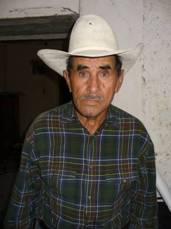
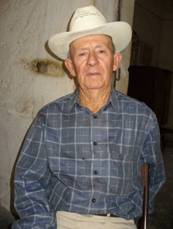
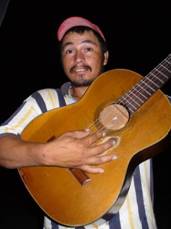
No quiero dejar pasar la oportunidad de
mencionar que cuando llamé a la puerta en casa de don Gustavo
Cano Coronado, sentí de inmediato su prestancia hospitalaria;
desde el preciso momento cuando a primera vista de nuestras caras
él dijo: “pásale te estaba esperando” …
todavía no termino de preguntarme porqué dijo eso,
si él no sabía que yo iba a llegar.
Pero mejor pienso nada al respecto, y es que
dicen que es de mala suerte ser supersticioso.
Que manera tan cordial de atender una visita
que no fue convidada.
No pude negarme a la invitación de comer al
medio dia un sabroso arroz y unos exquisitos chiles rellenos de
picadillo y de queso.
A media platica que ya estábamos bien
entrados don Gustavo Cano Coronado, su señora y yo, se escucha
alguien toca la puerta y ya luego llegan y entran un señor y una
muchacha; ellos son don Godofrey Polanco González, que nació en
Burgos en 1930, hijo de Félix Polanco y de Tomasa González;
la muchacha, no supe cómo se llamaba, pero es como de
algunos 45 años; a
Godofrey se le veía entusiasmado y no era para menos, ahí estaba
y había llegado para participar a sus vecinos y amigos, el
compromiso nupcial contraído recientemente con la señora que le
acompañaba.
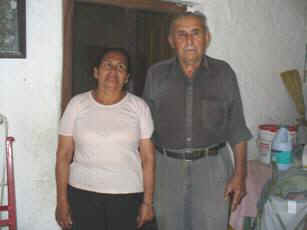
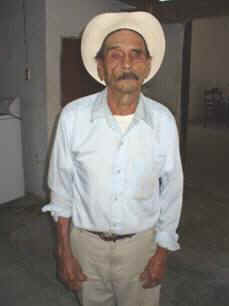
Entonces estoy como a las 12:30 del dia con don Gustavo Cano
Coronado; él me dice
que de lo que se acuerda a sus 82 años, es que su ancestro Justo
Cano se casó con Micaela Robles, y lo siguiente es su genealogía:
1.-
Félix Cano casó con Petra Treviño<?xml:namespace prefix = o
ns = "urn:schemas-microsoft-com:office:office" />
1.1.-
Justo Cano casó con Micaela Robles.
1.1.1.-
Severo Cano Robles nació por 1853 y casó con Luz Zúñiga
1.1.1.1.-
Rodolfo Cano Zúñiga.
1.1.1.1.1.-
José Cano; casó con una “de la Garza”
1.1.1.1.2.-
Tadeo Cano; se fue para Pharr, Texas.
1.1.1.1.3.-
Roberto Cano; casó con Ana Chávez; se fue a Pharr, Tx.
1.1.1.1.4.-
Rodolfo Cano; casó y se fue a vivir a California.
1.1.1.1.5.-
Severo Cano, nació en Burgos Tam.
el 21 de diciembre de
1902.
1.1.1.2.-
Everardo Cano Zúñiga nació por 1878; casó con María Ángela
Zúñiga; y en segundas nupcias casó con Severiana
Coronado.
1.1.1.2.1.-
Arturo Cano Zúñiga; casó con Juanita Coronado, hermana de
Severiana Coronado, la
segunda esposa su papá; y también
hermana de Juan Coronado, esposo de su cuñada Susana Cano
Zúñiga.
1.1.1.2.2.-
Angelita Cano Zúñiga; casó con Ambrosio García.
1.1.1.2.3.-
Susana Cano Zúñiga; casó con Juan Coronado.
1.1.1.2.4.-
Anita Cano Zúñiga; casó con Julián García, hermano de Nicasio
García; el esposo de su cuñada Jacinta Cano Coronado.
1.1.1.2.5.-
Antonio Cano Coronado; casó con Victoria Zúñiga.
1.1.1.2.6.-
Jacinta Cano Coronado; casó con Nicasio García.
1.1.1.2.7.-
Sofía Cano Coronado; casó con César Treviño.
1.1.1.2.8.-
Gustavo Cano Coronado; nació en Burgos, Tamaulipas el 8 de
enero de 1926; casó con Anita Galván, y en segundas
nupcias con
María del Socorro Mendoza.
1.1.1.2.9.-
Paulita Cano Coronado; casó con Juan Ramírez, hermano de
Carlos Ramírez, el esposo de su cuñada Lilia Cano
Coronado;.
1.1.1.2.10.-
Porfirio Cano Coronado; emigró para California.
1.1.1.2.11.-
Lilia Cano Coronado; casó con Carlos Ramírez.
1.1.1.2.12.-
Ramiro Cano Coronado; casó con Santos Cuevas.
1.1.1.2.13.-
Manuela Cano Coronado; casó con Adán Zúñiga; primo de
Victoria Zúñiga, la esposa de Antonio Cano Coronado.
1.1.1.2.14.-
Bertha Cano Coronado; fue soltera, no se casó.
1.1.1.2.15.-
Rodolfo Cano Coronado; casó con Hercilia de León.
1.1.1.2.16.-
Sebastián Cano Coronado; casó con Celia Zúñiga.
1.1.1.2.17.-
Eduardo Cano Coronado; célibe.
1.1.1.3.-
Fernando Cano Zúñiga; casó con Emeteria Pérez.
1.1.1.3.1.-
Reynaldo Cano Pérez; casó con Pomposa Palacios.
1.1.1.3.2.-
Domingo Cano Pérez.
1.1.1.3.3.-
Carmela Cano Pérez; casó con Eleuterio Cano, hijo de Lorenzo
Cano.
1.1.1.3.4.-
Alicia Cano Pérez.
1.1.1.3.5.-
Fernando Cano Pérez; mejor conocido como “sellando”.
1.1.1.3.6.-
Genaro Cano Pérez; casó con Eugenia García.
1.1.1.3.7.-
Antonia Cano Pérez; casó con Santiago Sánchez.
1.1.1.3.8.-
Tomás Cano Pérez; se fue para Valle Hermoso, Tamaulipas.
1.1.1.4.-
Segundo Cano Zúñiga; casó con Julia Flores.
1.1.1.4.1.-
Eva Cano Flores; se fue para California.
1.1.1.4.2.-
Esthela Cano Flores; casó con Jesús Guerra.
1.1.1.4.3.-
Segundo Cano Flores; casó con Consuelo Cano de la Garza, hija
de Raymundo Cano González, y de Gregoria de la Garza
Flores.
1.1.1.4.4.-
Francisca Cano Flores; casó con Ramiro Rios.
1.1.1.4.5.-
Julia Cano Flores.
1.1.1.4.6.-
Marilú Cano Flores.
1.1.1.5.-
Justo Cano Zúñiga; casó con Celia Robles; del ejido El Sarnoso.
1.1.1.5.1.-
Justo Cano Robles; se
fue para Pharr, Tejas.
1.1.1.5.2.-
Severo Cano Robles; se fue para Pharr, Texas.
1.1.1.6.-
Manuela Cano Zúñiga; casó con Espiridión Robles; del Sarnoso.
1.1.1.6.1.-
Juan Robles Cano.
1.1.1.6.2.-
Reynaldo Robles Cano.
1.1.1.6.3.-
Manuel Robles Cano.
1.1.1.6.4.-
Manuela Robles Cano.
1.1.1.7.-
Loreto Cano Zúñiga; casó con Raquel Treviño; sin descendencia.
1.1.2.-
Paula Cano Robles (ella y Josefa su hermana se fueron a Tampico)
1.1.3.-
Josefa Cano Robles se casó con Samuel Kelly.
o sea que ya a esas alturas, eran las 6 y
media de la tarde y lo que siguió fue regresar al hotel por una
refrescante ducha y continuar pa’ lante.
Ya para terminar ese fructífero dia del
niño en Burgos, habría de regresar al restaurante “3 hermanos
Cano” para la cena y ver si podía encontrar por la plaza al
señor Elías Cano, que me habían dicho es la hora que él andaba
por ahí; y por suerte
estaba llegando de la labor, cansado y sudado.
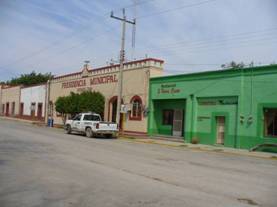
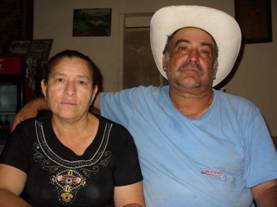
No puedo dejar de estar sorprendido por la amable disposición con la que
una vez mas las personas de Burgos están abiertas para platicar
la historia de sus familias.
Lo siguiente es la genealogía del señor José Elías Cano:
1.- José de Jesús Cano Solís, casó
con Micaela Polanco.
1.1.- Estanislao Cano Polanco, casó con Nicolasa Borrego.
1.1.1.- Elías Cano Borrego, casó con Lidia Zúñiga Elizondo.
1.1.1.1.- Jesús Cano Zúñiga, casó con Rosa Alonso.
1.1.1.2.- Horacio Cano Zúñiga, se casó con Elba Garza Zúñiga.
1.1.1.3.- Aroldo Cano Zúñiga, casó con Elba Chávez.
1.1.1.4.- José Elías Cano Zúñiga, casó con María Dávila.
1.1.1.5.- Concepción Cano Zúñiga.
1.1.1.6.- Heraldo Cano Zúñiga, casó con Laurentina Cisneros.
1.1.1.7.- Rosa Cano Zúñiga, casó con Feliberto Chávez.
1.1.1.8.- Ramiro Cano Zúñiga, casó con Gaudelia Cisneros.
1.1.1.9.- Nicolasa Cano Zúñiga, casó con Carlos Dávila.
1.1.1.10.- Estanislado Cano Zúñiga, casó con Silvia Cardona.
1.1.2.- Guadalupe Cano Borrego, casó con Israel Camarillo Garza.
1.1.2.1.- Raquel Camarillo Cano.
1.1.2.2.- Enedelia Camarillo Cano, casó con Juan Castañon
Vásquez.
1.1.2.3.- Israel Camarillo Cano.
1.1.2.4.- Gilberto Camarillo Cano, casó con Josefa García
Gutiérrez.
1.1.2.5.- Alicia Camarillo Cano.
1.1.2.6.- Miguel Ángel Camarillo Cano.
1.1.3.- Octavio Cano Borrego, casó con Consuelo Coronado.
1.1.3.1.- José Ángel Cano Coronado, casó con Lucila Sánchez.
1.1.3.2.- Moisés Cano Coronado.
Al
siguiente dia me enfrasqué con don Andrés Flores Cavazos, su
hermano don Luis y con don Inocente Cano Coronado, lisonjeros
amigos señores
ochenteros, con los que fui en carro por las calles del pueblo
reconociendo las casas donde vivieron algunas antiguas familias;
después estacionamos frente al hotel y entramos en una vieja casa
donde vivió don Miguel de la Garza y su esposa doña Dionicia de
la Garza.
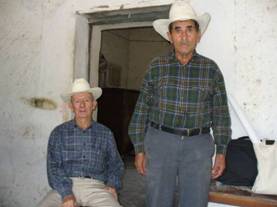
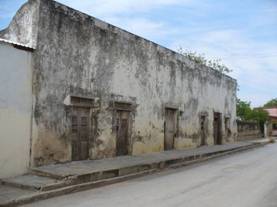
A
luego digo yo que al papá de Ciro R. de la Garza y Pepe de la
Garza del rancho Palos Blancos no he sabido de quien son hijos
ellos, y de pronto sin dudarlo arremete don Andrés Flores
afirmando que son hijos de Santos de la Garza; y además hace una
historia que platicaba la gente de antes de cuando El Pedernal ya
era un rancho grande allá por 1909, y que se desbordó el Rio
Conchos, y que toda la gente que ahí vivía
hubo de irse a otros lugares mas altos para resguardarse; y
que no era para menos porque eran cuatro rios que cuando llovía
se juntaban y que todo era mucha
agua.
Hubo
un momento en que pregunte sobre los minerales de la región; y me
dijeron que si, que aquí se extraían minerales, era el plomo y
también otra piedra blanca que brillaba como plata, quien sabe
como se llama; pero mas que todo eso era allá por San Nicolás y
San Carlos, no muy lejos de aquí.
Lo
que pasó con las minas fue que se vendían y cambiaban mucho de
dueño, luego se hizo una huelga de los trabajadores, las partes
no se pusieron de acuerdo y después ya nada siguió siendo bueno
para el mineral.
Mas
tarde fuimos a Los Chorros, lo que son cascadas de agua que se
forma por la confluencia de dos vertientes y que ya después
desemboca a un arroyo que circunda al pueblo de oeste a sureste.
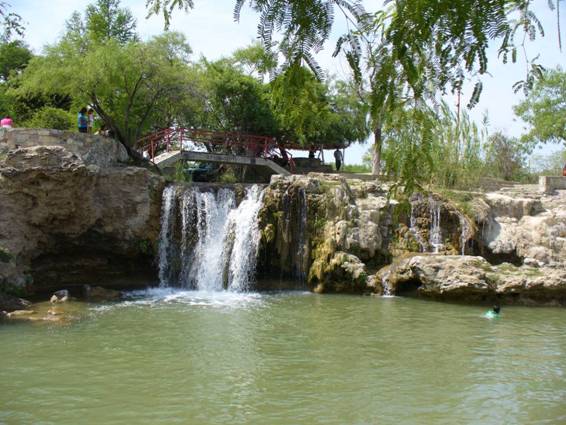
Los
Chorros
Burgos, Tamaulipas es pueblo hermano de Burgos, Santander, España,
y de Pharr, Texas, U.S.A. en marzo de 2007.
|
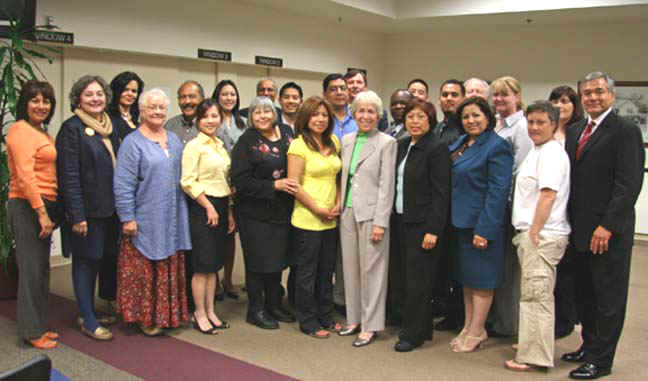
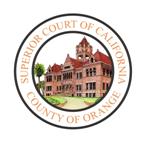
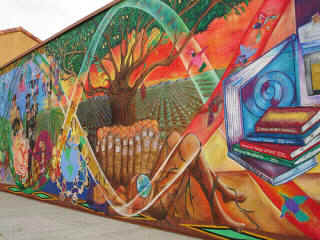

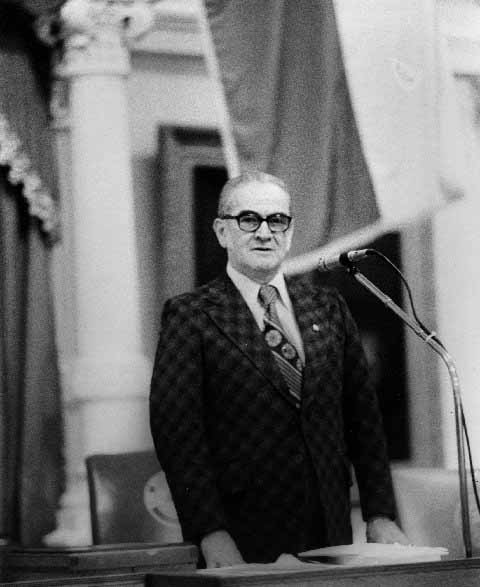 We are in the majority still poor but some of our own have moved into affluent areas. We have doctors, teachers, lawyers, engineers, and nurses by the thousands where 30 years ago they could be counted in the tens. You have made my dream become a reality. I am grateful, but more than that,
We are in the majority still poor but some of our own have moved into affluent areas. We have doctors, teachers, lawyers, engineers, and nurses by the thousands where 30 years ago they could be counted in the tens. You have made my dream become a reality. I am grateful, but more than that, 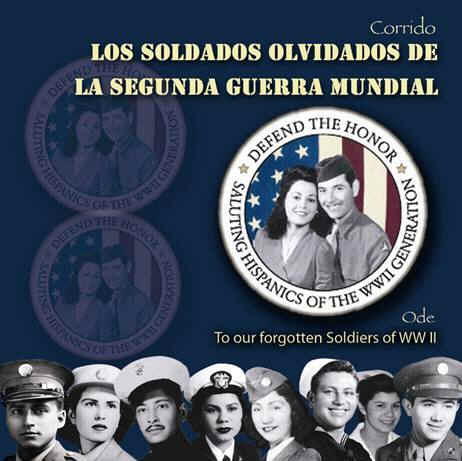
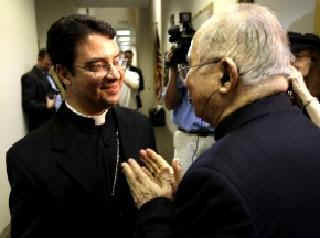 In a
move that will make him the youngest bishop in the nation, 41-year-old
Father Oscar Cantu was introduced as auxiliary bishop-elect for the
Archdiocese of San Antonio on Thursday at the chancery office.
In a
move that will make him the youngest bishop in the nation, 41-year-old
Father Oscar Cantu was introduced as auxiliary bishop-elect for the
Archdiocese of San Antonio on Thursday at the chancery office. 
 MIAMI (AP) -- Armed but alone, Marine Pfc. Guy Gabaldon roamed Saipan's caves and pillboxes, persuading enemy soldiers and civilians to surrender during the hellish World War II battle on the island.
MIAMI (AP) -- Armed but alone, Marine Pfc. Guy Gabaldon roamed Saipan's caves and pillboxes, persuading enemy soldiers and civilians to surrender during the hellish World War II battle on the island.

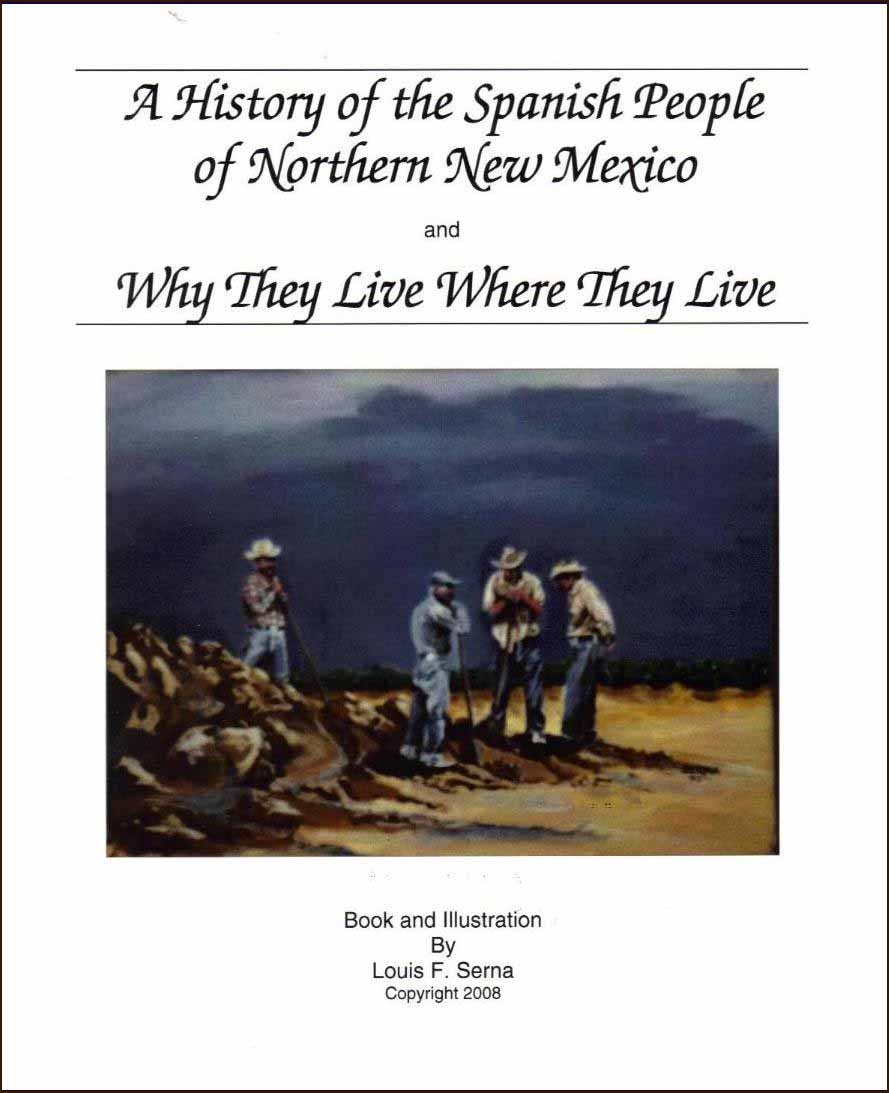
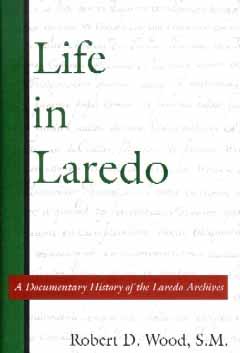
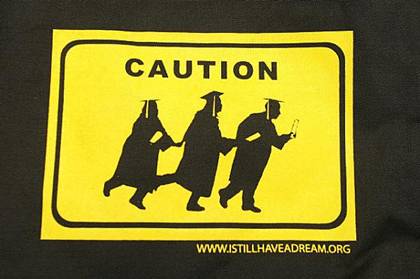
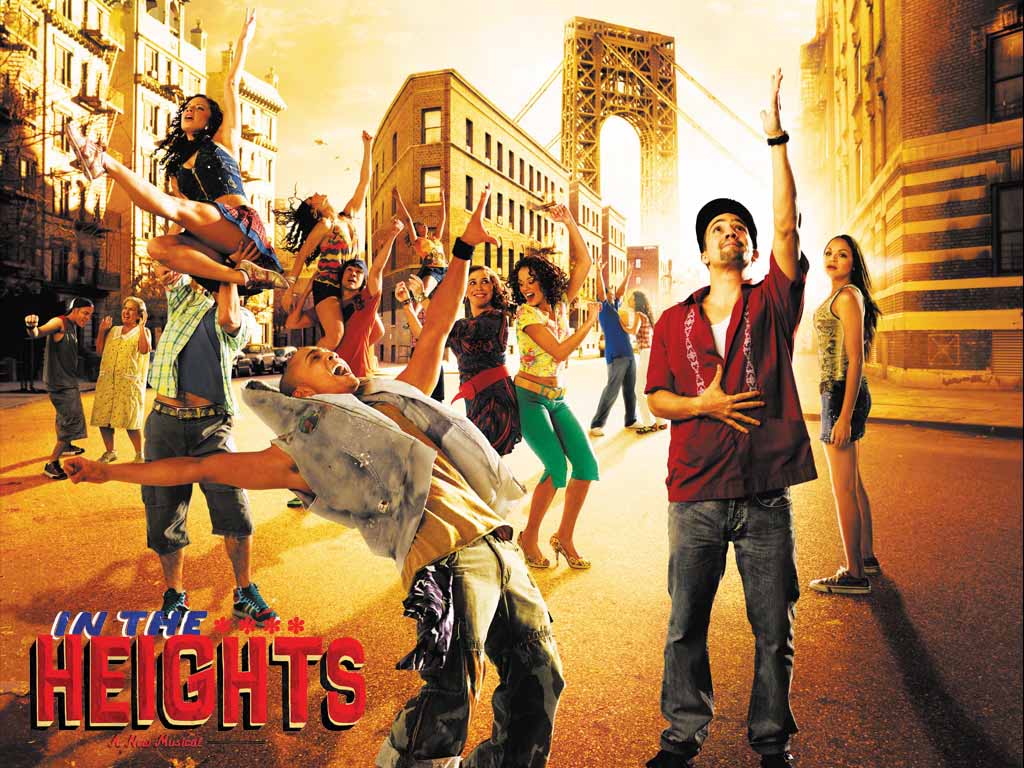
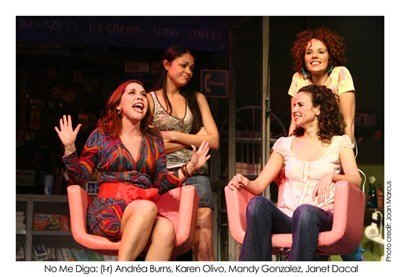 "In
the Heights" is a play about a new generation of Latinos who
strongly identify with their parents' Spanish-language culture while
simultaneously embracing urban street culture, which is mostly lived in
English.
"In
the Heights" is a play about a new generation of Latinos who
strongly identify with their parents' Spanish-language culture while
simultaneously embracing urban street culture, which is mostly lived in
English.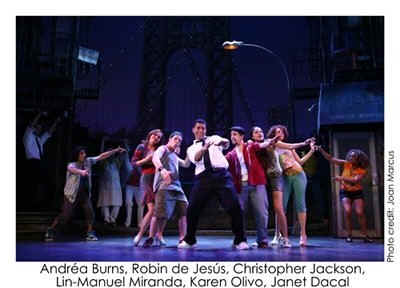 Over
the decades Broadway has not been very welcoming to Latino theme
productions. In fact only three Latino musicals have made it to
Broadway. The wait appear worth the effort since In The Heights is up
for 13 Tonys this Sunday - more than any other production. The music and
lyrics are by Lin-Manuel Miranda who also stars in the musical. You see
a number from In The Heights at broadway.com/gen/general.aspx?ci=565362
and you can watch the Tony on Sunday, June 15th on CBS.
Over
the decades Broadway has not been very welcoming to Latino theme
productions. In fact only three Latino musicals have made it to
Broadway. The wait appear worth the effort since In The Heights is up
for 13 Tonys this Sunday - more than any other production. The music and
lyrics are by Lin-Manuel Miranda who also stars in the musical. You see
a number from In The Heights at broadway.com/gen/general.aspx?ci=565362
and you can watch the Tony on Sunday, June 15th on CBS.
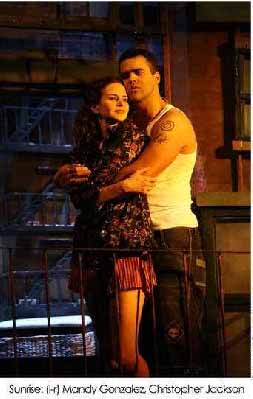
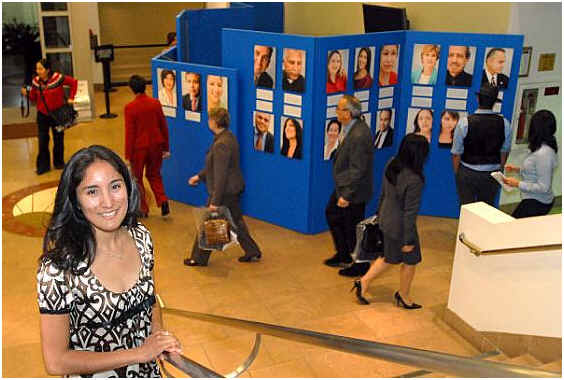
 In
"Portrait of Ten Women," ten Latinas share their stories of
learning to live with HIV and AIDS, from feeling despair and facing
society's disdain, to dealing with the prospect
In
"Portrait of Ten Women," ten Latinas share their stories of
learning to live with HIV and AIDS, from feeling despair and facing
society's disdain, to dealing with the prospect 
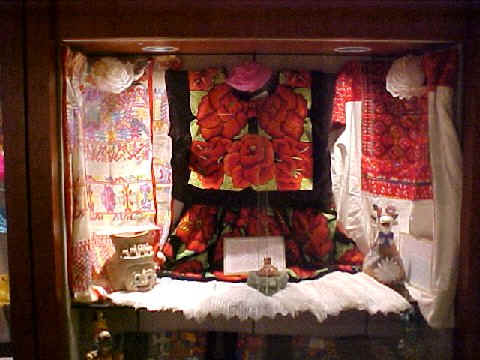
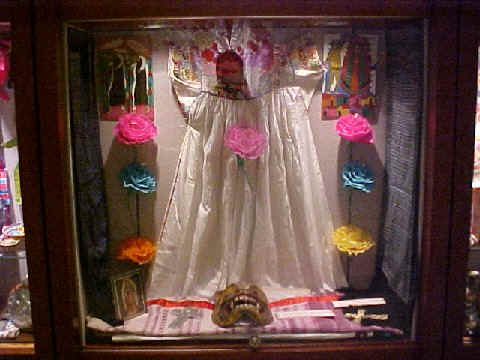




 Dr.
Henry J. Casso and Dr. Tom Chavez, of Albuquerque, New Mexico, are guiding
an initi
Dr.
Henry J. Casso and Dr. Tom Chavez, of Albuquerque, New Mexico, are guiding
an initi
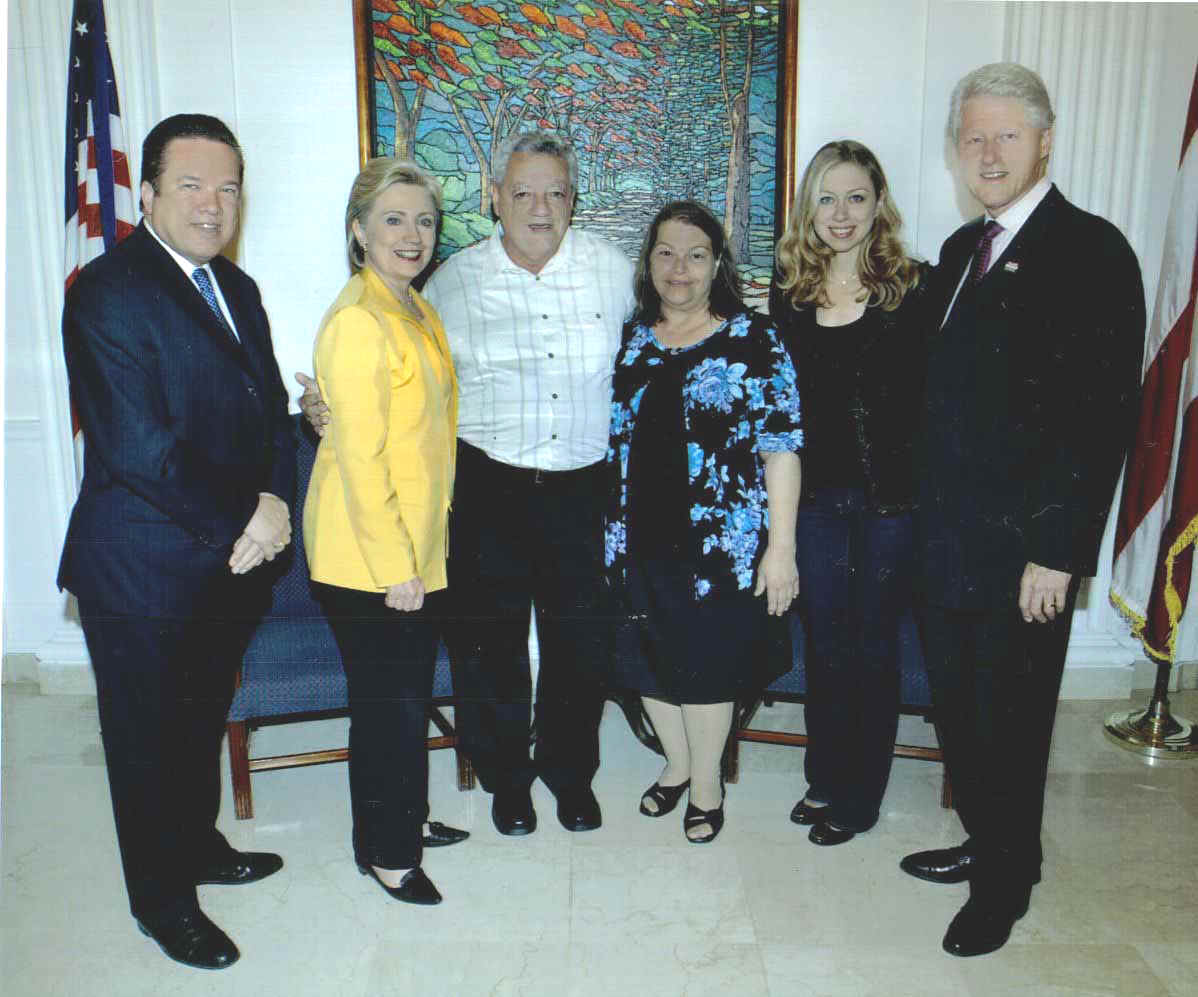
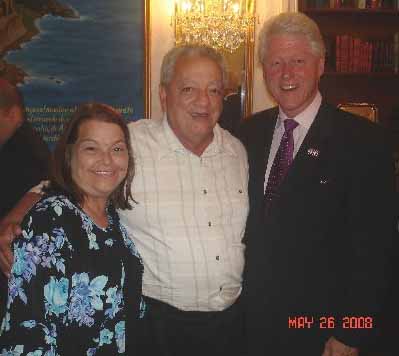
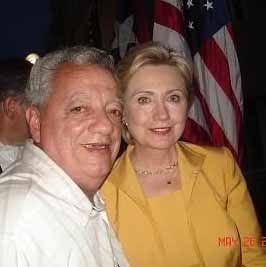
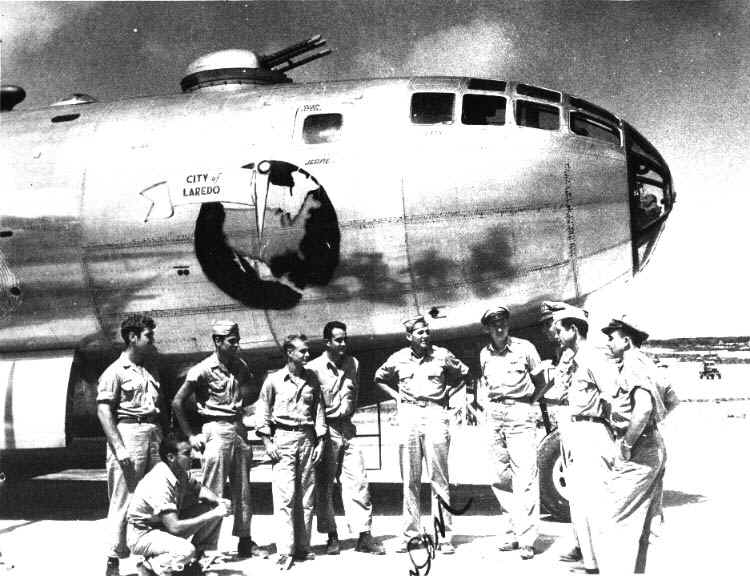
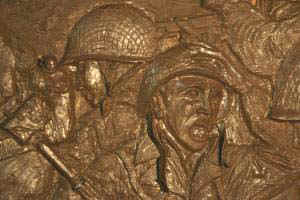
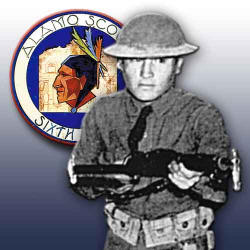

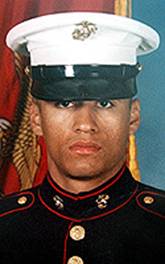
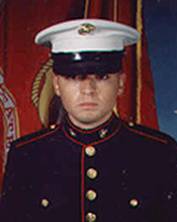
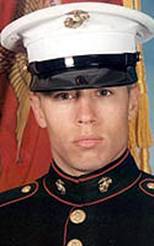
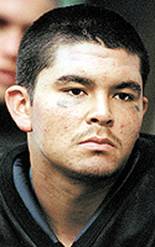
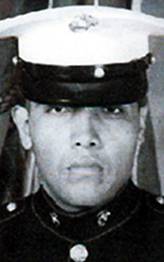
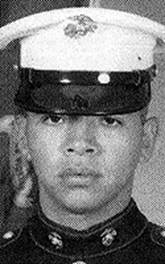
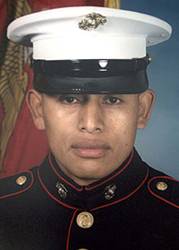
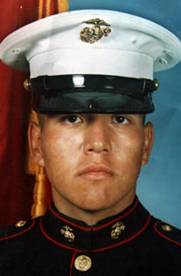
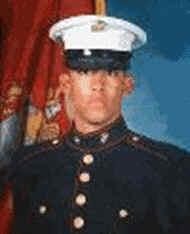
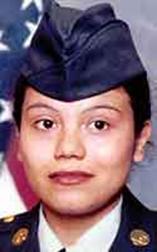
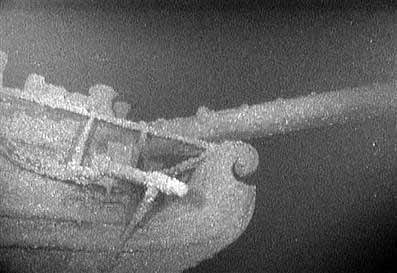
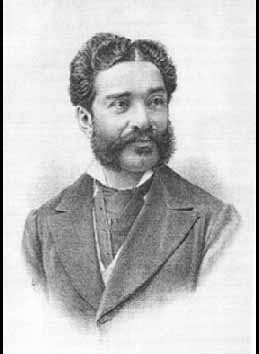
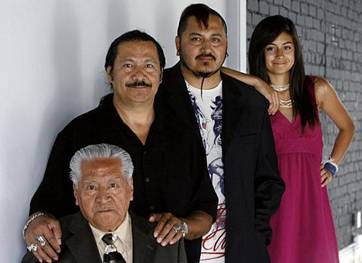
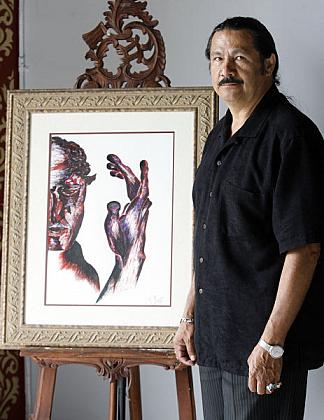
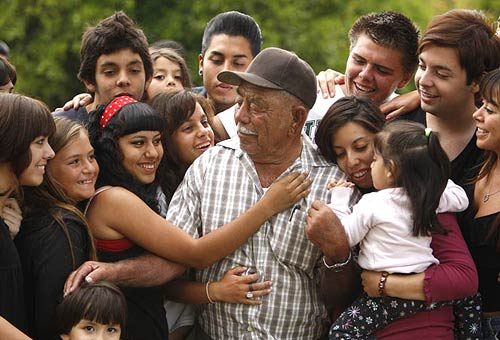
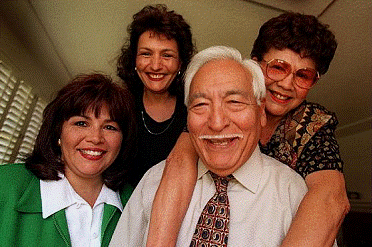
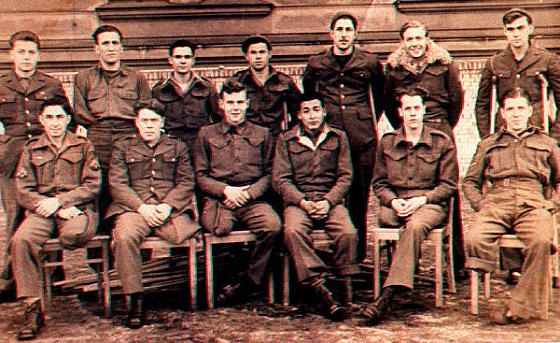

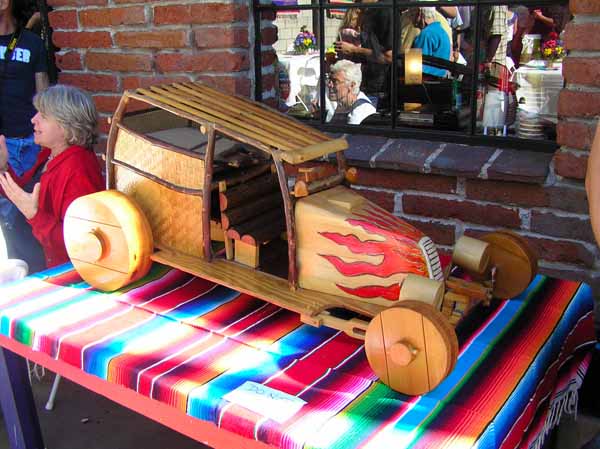
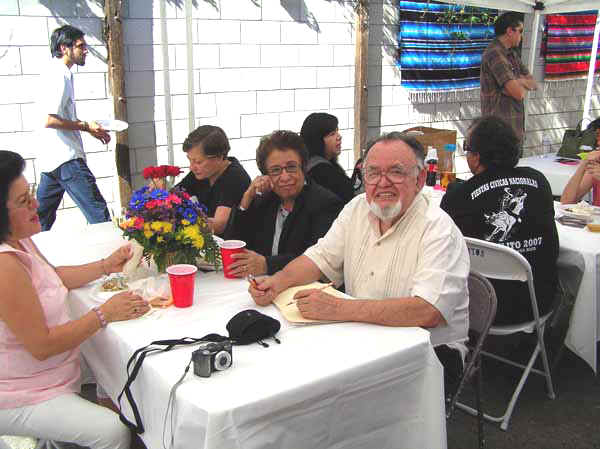
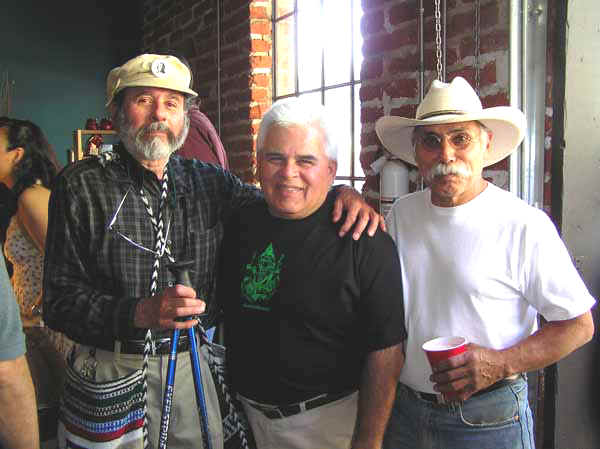
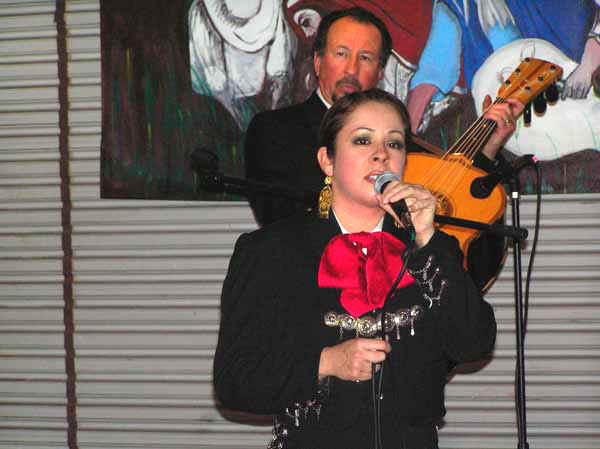
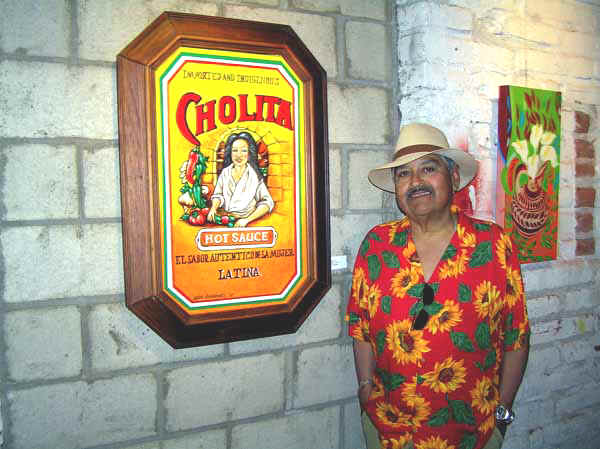
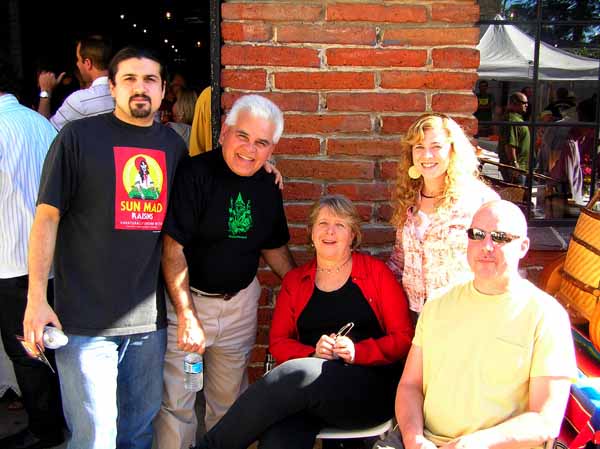
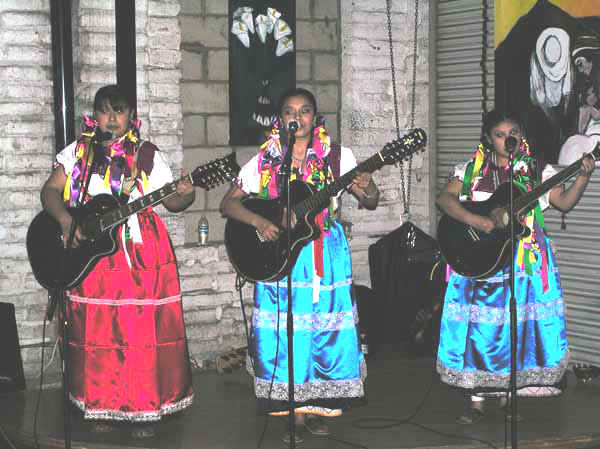
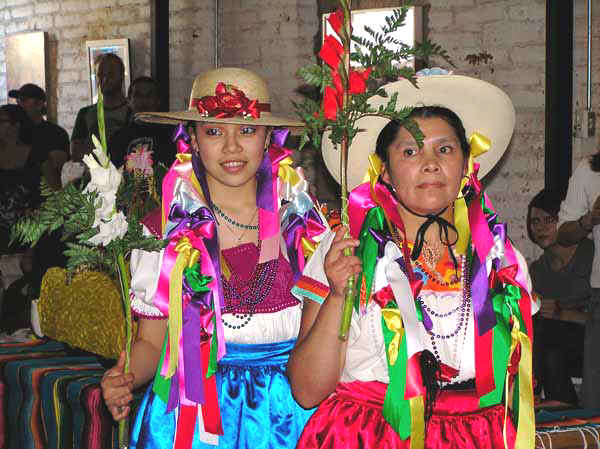
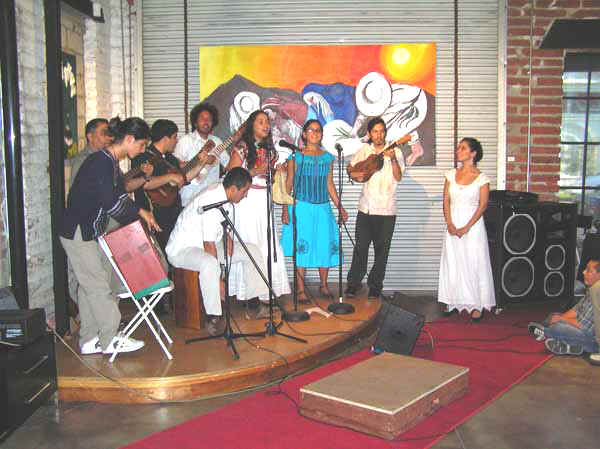
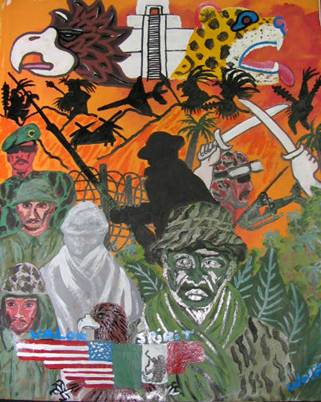
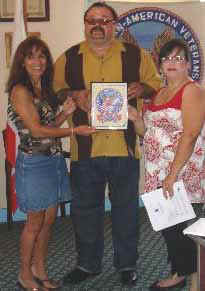



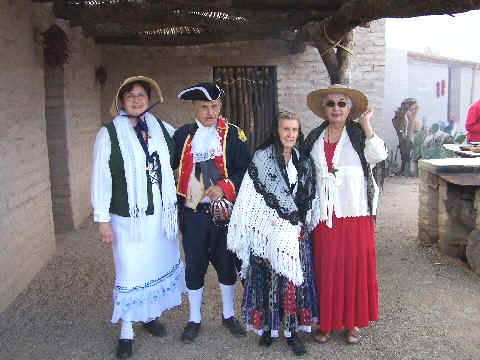
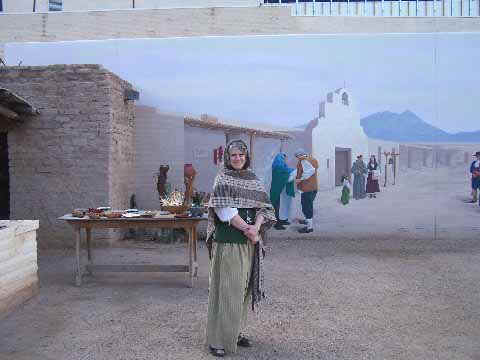
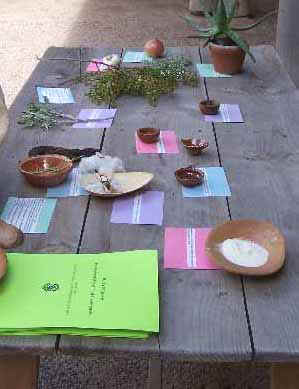
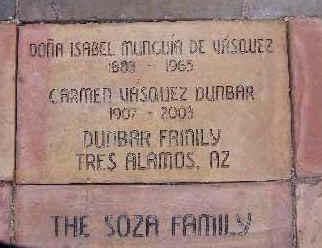
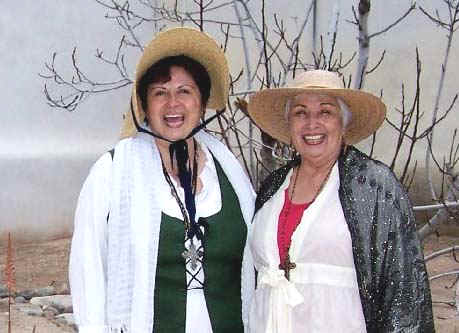
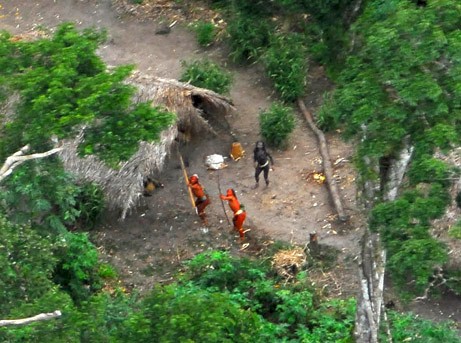
 Once banned by Cortez and the Catholic church, amaranth is still a fairly unknown high-protein grain that could easily figure into the solution to world hunger. Instead, amaranth became an outlaw, an illegal alien grain in its own homeland. This was likely triggered by the high esteem in which the plant was held by indigenous people, and rightly so.
Once banned by Cortez and the Catholic church, amaranth is still a fairly unknown high-protein grain that could easily figure into the solution to world hunger. Instead, amaranth became an outlaw, an illegal alien grain in its own homeland. This was likely triggered by the high esteem in which the plant was held by indigenous people, and rightly so. 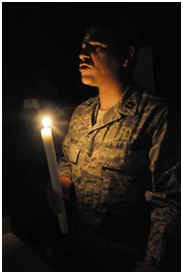 5/7/2008 - SOUTHWEST ASIA
(AFPN) -- The candle flame danced a slow mesmerizing dance as it flickered from one side of the wick to the next. The light softly illuminated his face as his silhouette became a portion of the projection behind him -- images of Holocaust victims. Soft-spoken yet with a stern demeanor, Rabbi (Capt.) Raphael Berdugo's eyes glistened as he solemnly lead a prayer in Yiddish.
5/7/2008 - SOUTHWEST ASIA
(AFPN) -- The candle flame danced a slow mesmerizing dance as it flickered from one side of the wick to the next. The light softly illuminated his face as his silhouette became a portion of the projection behind him -- images of Holocaust victims. Soft-spoken yet with a stern demeanor, Rabbi (Capt.) Raphael Berdugo's eyes glistened as he solemnly lead a prayer in Yiddish. 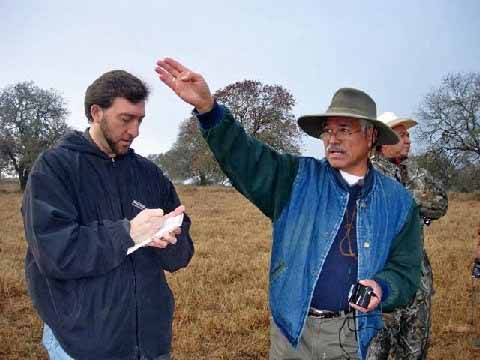
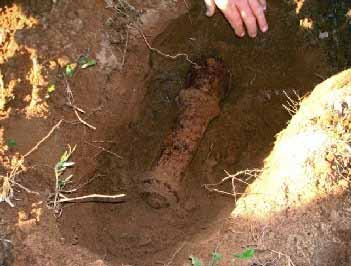
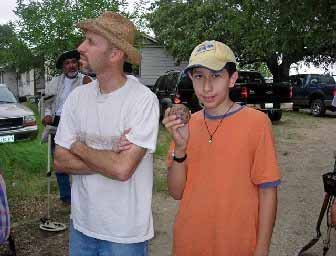
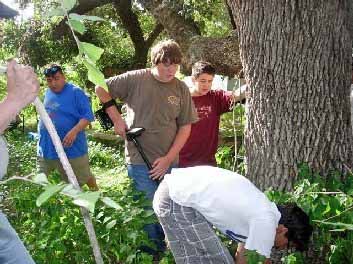
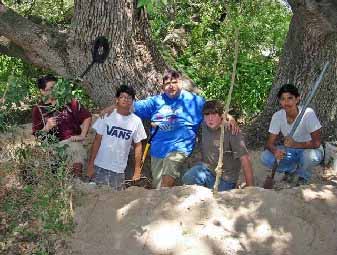
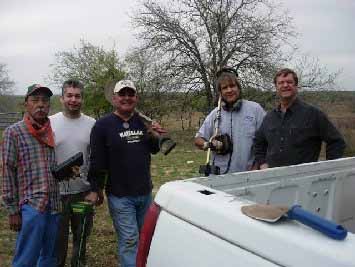
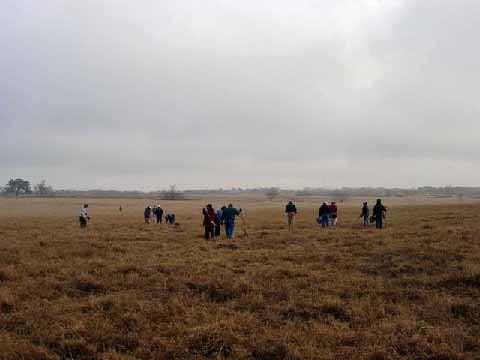
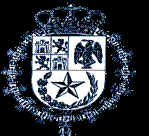
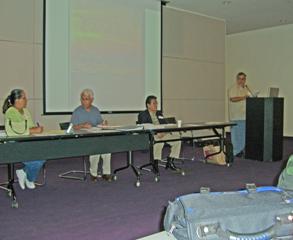
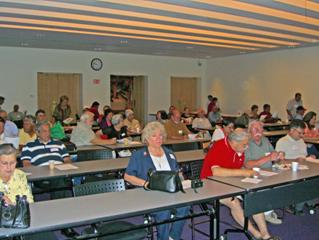
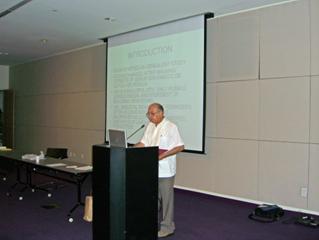
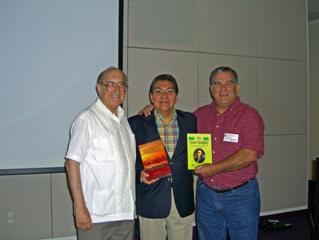
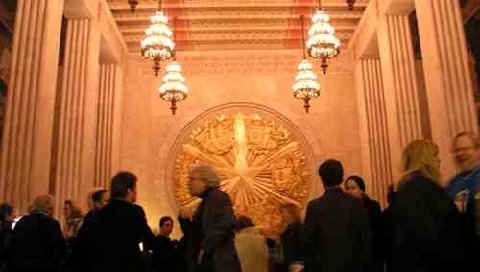
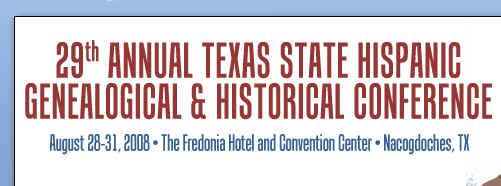
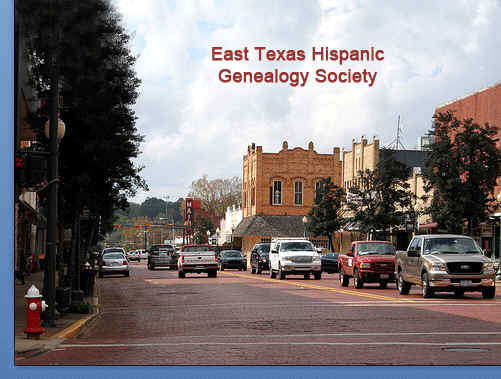
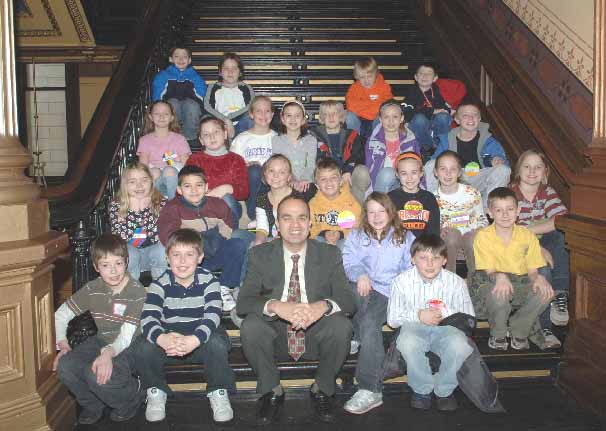
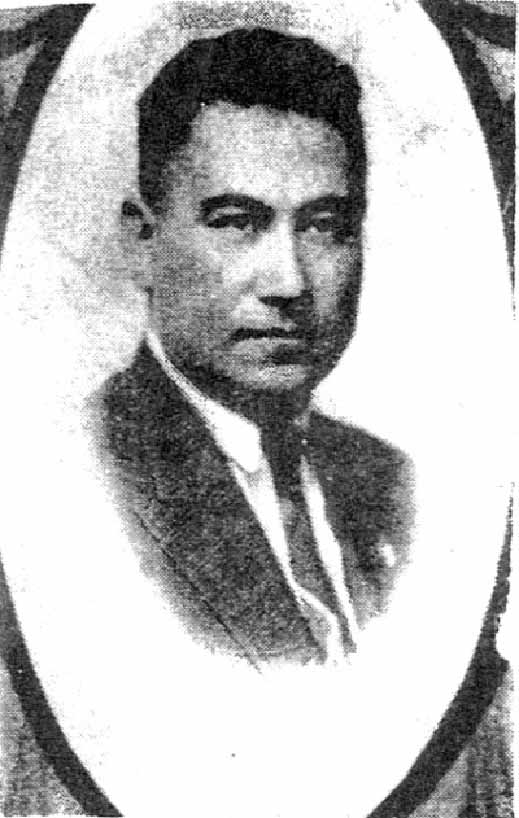
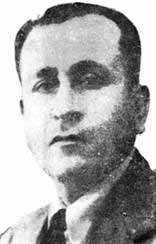
















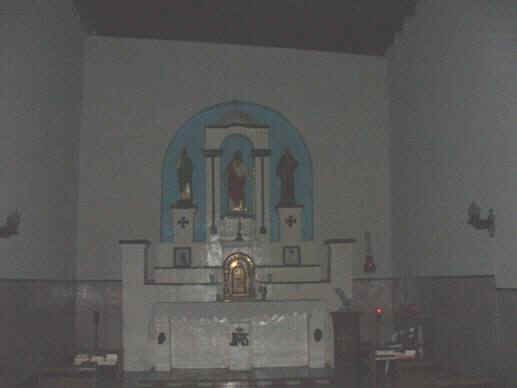
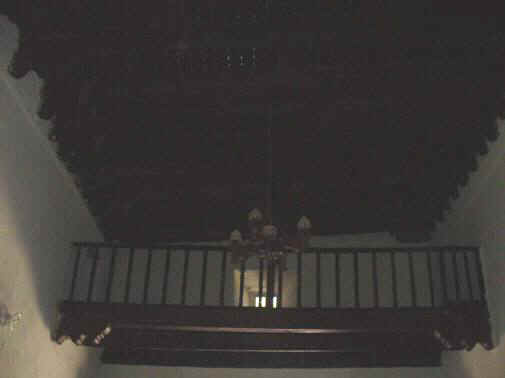
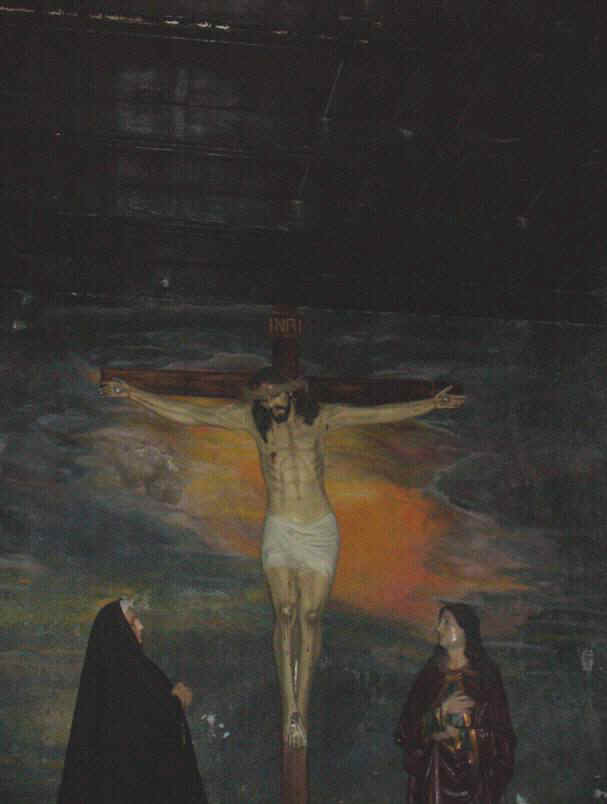
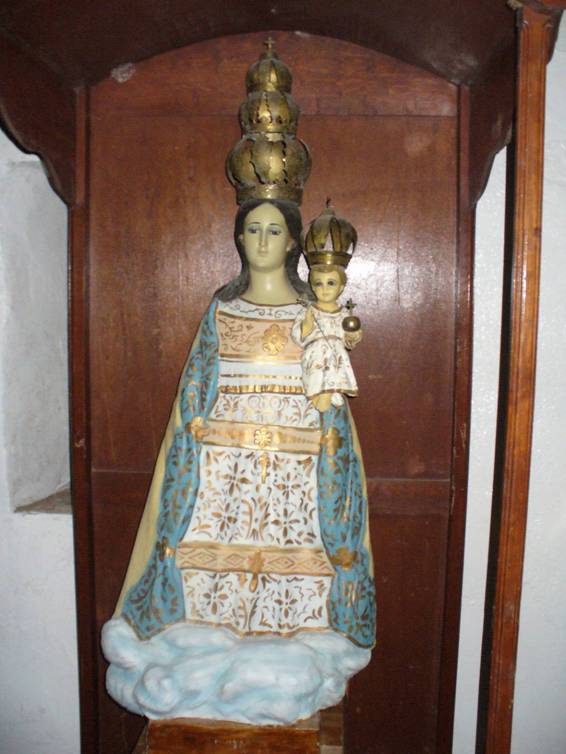
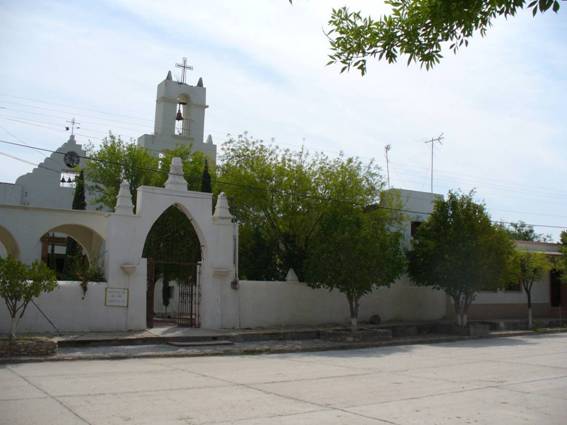
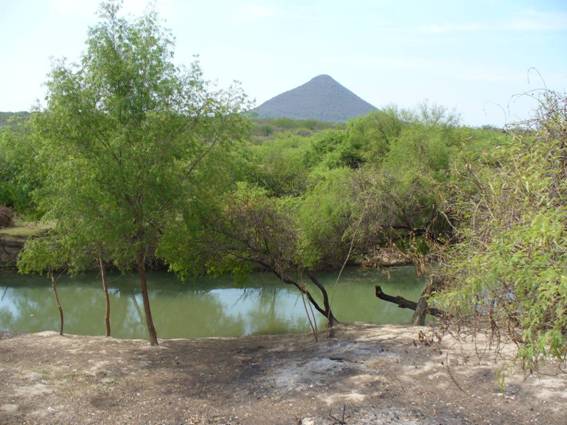
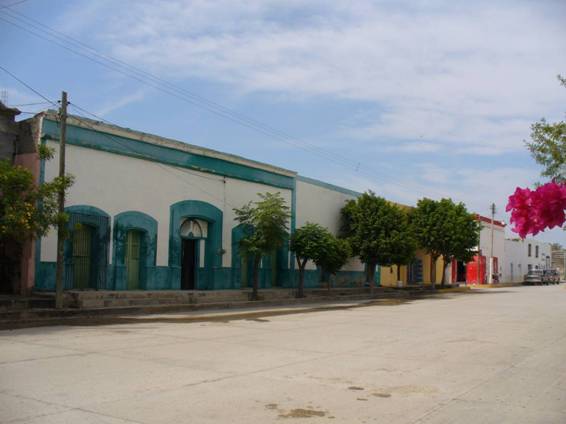
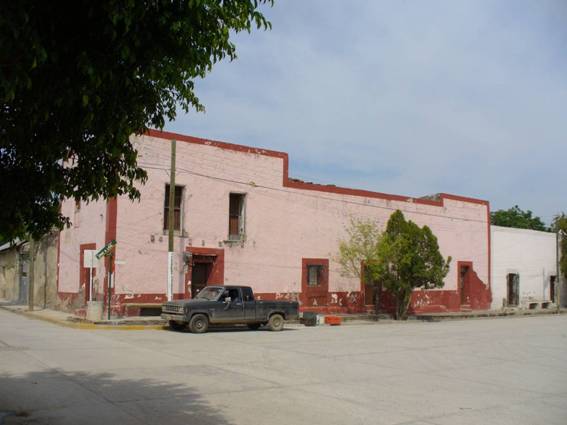
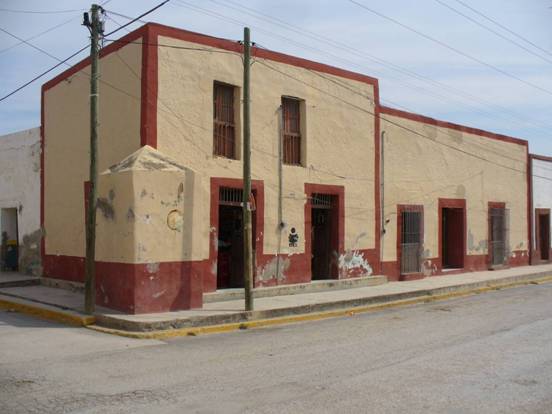
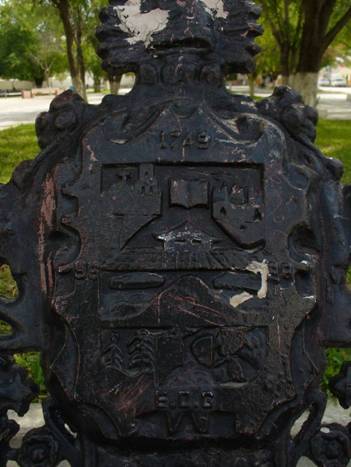
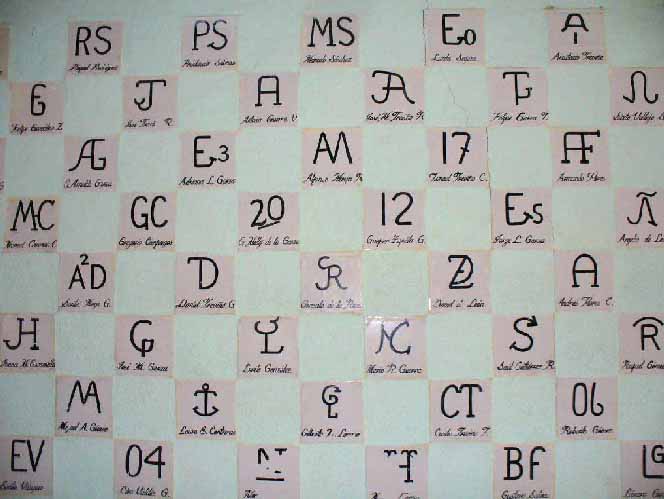
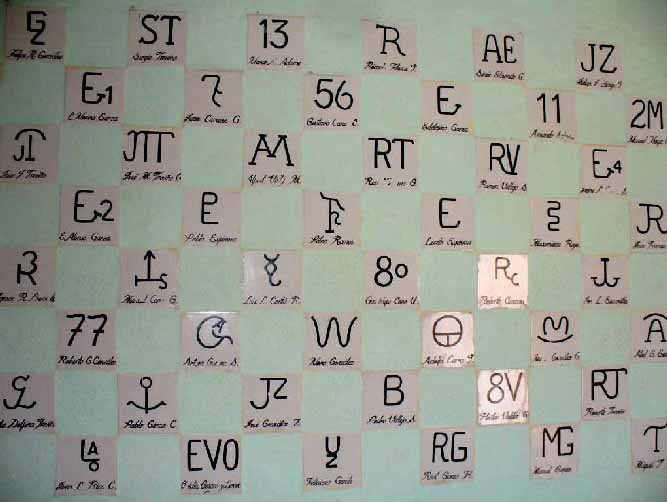
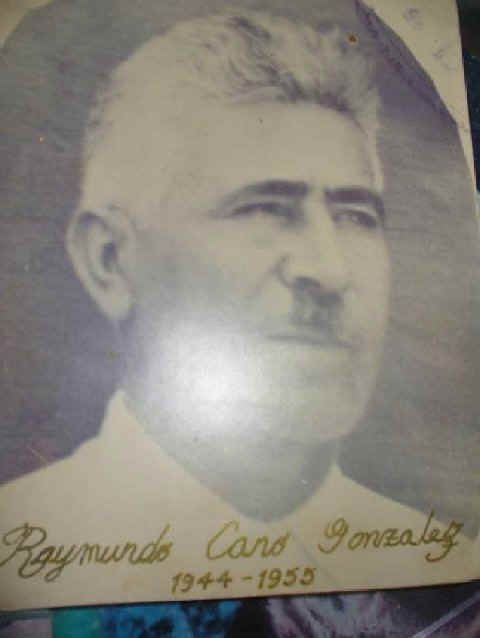
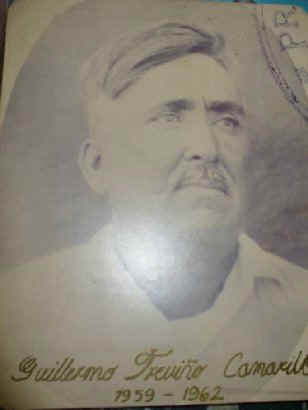
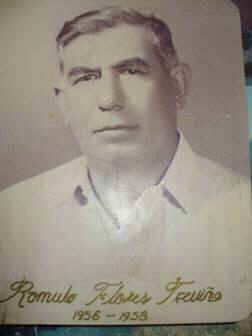
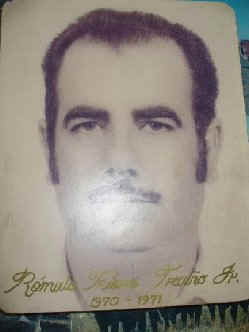

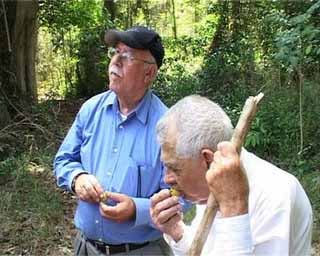
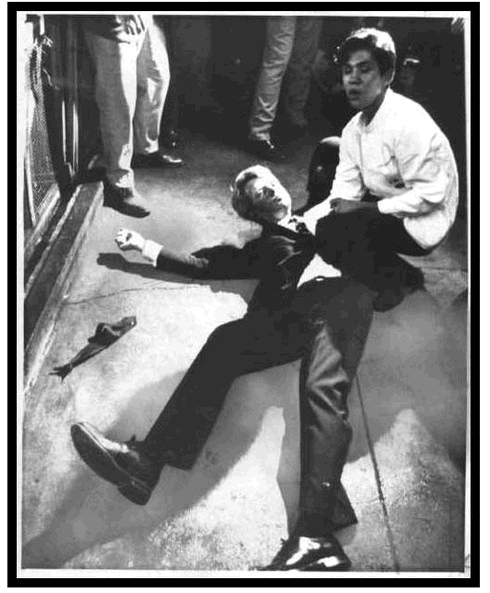
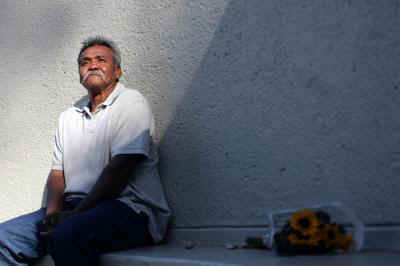 After years of avoiding the limelight, haunted by the infamous photo of the young busboy holding the dying candidate, Romero now happily shares his experience, both the life lessons learned and the dreams broken forever.
After years of avoiding the limelight, haunted by the infamous photo of the young busboy holding the dying candidate, Romero now happily shares his experience, both the life lessons learned and the dreams broken forever. 